Circulation Notice: Stair Design Gets People Talking
Ornamental stairs create spaces for circulation, gathering, and artistic expression throughout New York City
![]() Continuing Education
Continuing Education
Use the following learning objectives to focus your study while reading this month’s Continuing Education article.
Learning Objectives - After reading this article, you will be able to:
- Identify and recognize the necessary and building code-related characteristics of stairs for safe vertical circulation.
- Investigate the design potential and innovative opportunities to create gathering spaces within buildings using stairways while maintaining fire safety.
- Assess the ability of stairs to act as a design focal point or feature within the context of the larger building including smoke evacuated atriums.
- Explore the ways that stairs can be designed as an artistic element in their own right within a building and still meet structural and code requirements.
Interior stairs are a common element in any multistory building. Beyond meeting basic requirements for pedestrian circulation they must also meet the full array of code requirements for safety and public welfare. But once these conditions are mastered, architects can configure stairs in such a way that they transcend their circulation function and become truly unique and appealing features in their own right.
Vertical Circulation—Connecting People Not Just Floor Levels
We often think of the basic purpose of stairs as connecting vertical floor levels in a building. Indeed, building codes require such stairs for safe passage out of a building and dictate minimum requirements to achieve that safety in terms of size, details, enclosure, the presence of guardrails and handrails. While all of these things are clearly important and deserve proper attention, the real day-to-day use of stairs can be to make it easy for people to connect to other people within a building, not just creating a floor by floor exiting path. Three buildings in particular that have taken this approach are great examples of using stairs to make people feel more connected to each other.
The New York Times Building
Owners: The New York Times Company New York, NY
Forest City Ratner Companies Brooklyn, NY
Developer: Forest City Ratner Companies Brooklyn, NY
Architects: Renzo Piano Building Workshop Paris, France
FXFowle Architects, PC New York, NY
Structural Engineer: The Thornton Tomasetti Group, Inc. New York, NY
General Contractor: AMEC, New York NY
Structural Steel Erector: DCM Erectors, Inc. New York, NY
Miscellaneous Steel Fabricators and Erectors: Empire City Iron Works
Long Island City, NY; Skyline Steel Corp. Brooklyn, NY
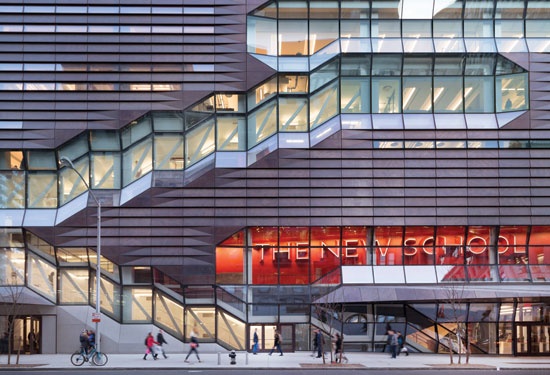
Photo © Tex Jernigan
The uncoiled stair profiles are expressed on the exterior of the New School University Center and are equally inviting on the interior as a place to gather (see page 3 for project details).
When designing the 52-story, 1.6-million-square-foot headquarters for The New York Times Company, Pritzker prize-winning architect Renzo Piano and designers at New York-based FXFOWLE Architects sought to infuse the building with a sense of lightness and transparency, in part for purely aesthetic reasons, but also to communicate the idea of transparency at The New York Times. This thought process carried through on the interior of the building as well. In a city where the corner of a building is usually given over to an executive office, the New York Times building used the corner to create an open intercommunicating stair between floors. This stair was designed to serve the singular purpose of helping people work and communicate better—together.
This building represents a significant commitment to this interconnected approach to the workplace. First, these stairs are separate from the fully enclosed fire stairs, meaning there is an extra expense involved in adding these interconnecting stairs. However, this was seen as an investment by the owner that was critical for the successful operation of a very vertical workspace. Second, it took some ingenuity to meet New York City fire codes that don't allow more than two floors to be connected together due to smoke control. In order to be code-compliant, the architects designed a horizontal fire shutter on every other floor level. The handrail and guardrail are interrupted creating a slot for the shutter to close during an alarm event. This would have been rather difficult with any other material, but the steel products used could be designed and fabricated to accommodate the shutters cleanly and elegantly.
The stairs are constructed of conventional metal pan and shaped flat steel stringers. The railings are in-filled with brightly painted sheet metal to serve both as guards and visual elements. The stairs are enclosed with mullion free glass to enhance the connectivity approach and still meet code requirements. All of this represents a significant design effort filled with ingenuity. But it was all justified by the owner's requirements and desire to change the way people work by using the built environment to demonstrate transparency and encourage human connections.
Albert Einstein College of Medicine
Location: 1301 Morris Park Avenue, Bronx, NY
Owner: Albert Einstein College of Medicine of Yeshiva University, New York, NY
Architect: Payette, Boston, MA
Structural Engineer: Weidlinger Associates, New York, NY
Mechanical Engineer: WSP Flack + Kurtz, New York, NY
General Contractor: Tishman Construction, New York, NY
Ornamental Metal Fabricator and Erector: Empire City Iron Works, Long Island City, NY
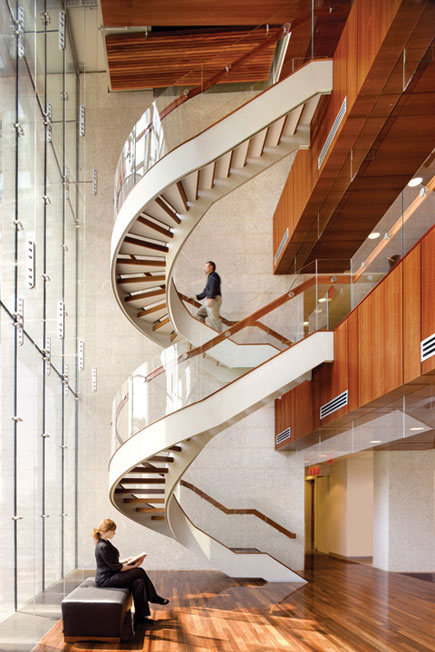
Photo © Robert Benson Photography
The Albert Einstein College of Medicine stairway fosters collaboration and interaction while mimicking the DNA shape that those in the building are attentive to.
When the Albert Einstein College of Medicine began planning for its first major research facility in two decades, the administration decided it wanted to create a uniquely collaborative environment that would foster interaction and cross-pollination among the facility's 40-odd research teams. In response, Payette—the architectural firm selected to design the Michael F. Price Center for Genetic and Translational Medicine—conceptualized an L-shaped building with wet labs in the two wings and a dramatic glass-enclosed atrium and core at their juncture. The atrium, with its light and airy common spaces, is specifically designed to draw scientists together for the sharing of ideas, while a dramatic two-story steel spiral staircase invites vertical circulation within the core of the building.
It is the stairway that ties it all together, literally and figuratively, encouraging the desired interaction. “Not only do you have cross-pollination happening on the floors but also between floors,” explains Chris Baylow, the project manager for Payette. Salvatore Ciampo, the senior director for facilities management at the college, says, “I love that it looks like DNA. It has relevance to what we do here. It's almost like a sign.” Like DNA, the stair acts as the catalyst for the research that takes place inside by connecting to a series of lounges on each floor where researchers congregate to eat, socialize, and relax. And because the stair is located in the building's inviting atrium, the hope is researchers and doctors will prefer it to the elevator. “This way, not only will the scientists on the same floor be bumping into each other and sharing ideas, but it will happen throughout the entire facility.”
Though it looks like a unified spiral, the stair is composed of two distinct flights, one connecting the second and third floors, another connecting the third and fourth with each flight fabricated off-site in three pieces. “It was originally planned to deliver each flight in one piece,” explains Richard Wolkowitz, vice president at Tishman Construction. “However, due to the fabrication schedule, the building façade glass could not be left open. Each flight was fully fabricated in the steel shop and then cut down into the three sections for delivery.” Upon delivery, the pieces were welded and ground smooth in place. Steel plates were embedded in the concrete floor slabs to receive the stringers. These connections were then welded and concealed by a wood fascia.
The structure of the stair system is a steel box stringer made of a series of ½-inch AISC architecturally exposed structural steel (AESS) built-up plate sections with continuous ¼-inch partial penetration fillet welds. Payette fitted the stairs with a glass handrail to mimic the atrium curtain wall, utilizing 18-inch-deep, ½-inch-thick monolithic low-iron glass. The glass is recessed into the stringer and held in place with non-shrink grout. It is also fitted with a mahogany railing that echoes the wooden motif found throughout much of the interior. The railing is then fitted to the glass with stainless steel brackets. The stair's steel plate treads, which were welded to the stringer, were fitted with wood treads and screwed in place. The end result is an elegant and inviting means to draw people together and connect their working thoughts and ideas.
Medgar Evers College Academic Building 1
Location: 1150 Carroll Street, Brooklyn, NY
Owner: City University of New York, New York, NY
Agency: Dormitory Authority of the State of New York, New York, NY
Architect: Ennead Architects, New York, NY
Structural Engineer: Leslie E. Robertson Associates R.L.L.P., New York, NY
General Contractor or Construction Manager: The McKissack Group, New York, NY;
Turner Construction, New York, NY
Ornamental Metal Fabricator and Erector: RISA Management Corp., Westbury, NY
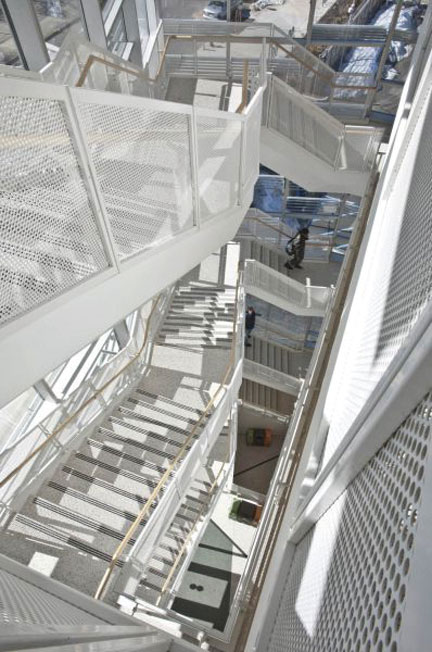
Photo courtesy of LERA
Well-designed metal stairs can be used to connect people as well as floors and serve as artistic focal points in a building.
Far from your average brick-block campus building, the Academic Science Building 1 of Medgar Evers College, City University of New York in Brooklyn, is an elegant glass and steel centerpiece for a campus poised to become a neighborhood hub. A joint undertaking between the City University of New York, the Dormitory Authority of the State of New York, Ennead Architects (formerly Polshek Partnership), and Leslie E. Roberts Associates (LERA), the new six-story academic facility features four teaching laboratories, a hospital simulation room, and five laboratories for molecular biology, anatomy, physiology, microbiology, and general biology. All of these facilities are linked by a pair of feature staircases on its eastern and western facades and capped at the north end by a crystalline floor-to-ceiling glass curtain wall pavilion.
Tasked with opening campus activities up to the community at large, while still fulfilling the exacting functional requirements demanded by the lab facilities, the architects at Ennead turned to structural steel to achieve a balance between form and function. “These days academic buildings have shifted away from fixed spaces,” says Todd Schliemann, lead architect for Ennead. “They're a little more flexible and there's a desire to expose the faculty to the students more, so that there's more interaction.”
It was this use of steel that played a pivotal role in showcasing the feature stairs on the building's eastern and western facades. Commonly relegated to secondary structural roles and confined to enclosures, the science building uses open feature stairs that appear to float like bridges between the floors, further emphasizing the project's goal of transparency and community inclusion. “Often times in a multi-storied building you just live in a slice on a floor, unaware that you're part of a larger community,” says architect Schliemann. “These stairs link the whole building together in such a way that you can see people moving through this big volume all the way up the building. It's part psychological and part circulation, but you're aware that you're a part of this bigger academic community.”
To achieve the long vertical spans between floor levels without adding too much bulk, the designers framed each flight with a single 36-foot-long HSS 24x2x½ spanning member, bent in plane and elevation, and spliced together at the kink points via full penetration butt welds made in the shop. The stair structure is also used in resisting the effects of wind load on the glass and aluminum curtain wall, which is braced back to the stair by a series of 2½-by-10-inch split aluminum tubes that bear on the top of the foundation wall at ground level and laterally brace at the floor slabs and stair stringers. While the floor slab connections are hidden, the curtain wall and stair connections engage the tube mullions via a series of tuning fork-shaped aluminum extrusions with bolted connections that allow for thermal expansion and contraction.
Gathering Spaces—Taking Time to Collaborate
As the previous three examples demonstrate, stairs can link people on different levels in a building, but what about linking people in the stair areas directly? Let's turn to three examples that looked at stairs not only as a place for people to pass through but a place to stop, meet, rest, refresh, or just talk.
John Jay College of Criminal Justice
Location: 524 West 59th Street, New York, NY
Owners: The City University of New York John Jay College of Criminal Justice, New York, NY; Dormitory Authority of the State of New York, New York, NY
Architect: Skidmore, Owings & Merrill LLP, New York, NY
Structural Engineer: Leslie E. Robertson Associates, New York, NY
Construction Manager: Turner Construction, New York, NY
Structural Steel Erector: Cornell & Company Inc., Westville, NJ
Miscellaneous Iron Fabricator and Erector: United Iron, Inc., Mt. Vernon, NY
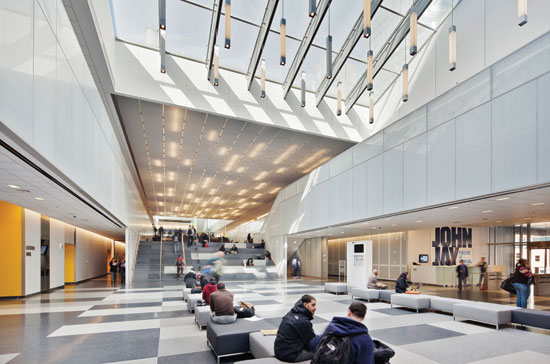
Photo © Eduard Huber
The interconnecting corridor at the John Jay College of Criminal Justice includes large meeting areas and food service facilities.
The team of architects and engineers who designed the recent expansion of the John Jay College of Criminal Justice faced an array of challenges when designing a new tower sited on 11th Avenue between 58th and 59th streets. The tower design, envisioned by architecture firm Skidmore, Owings & Merrill (SOM) as a vertical campus, is essentially a stacked academic program that seeks to offer the same opportunities of random encounter and collaboration common to more traditional campuses. The final design called for double-height spaces and 50-foot clear spans through the center of the building. In the words of Jason Stone, associate at structural engineering firm LERA, “Steel was the obvious choice because it's lighter than reinforced concrete and keeps the loads down. It was also the only option for the project's long span areas.”
The tower and a 500-foot-long podium that connects the addition to John Jay's existing facilities on 10th Avenue make up a 620,000-square-foot expansion at the college. SOM took advantage of this long, low podium space, as well as the nearly two-story grade change between 10th and 11th avenues, to solve one of the problems of urban campus design. “One of the greatest challenges in city colleges is how to move a multitude of students who have to go from class to class in 10 minutes over various floors,” says Mustafa Abadan, the SOM partner in charge of the project. In the podium, the architects arranged classroom functions around a cascading circulation corridor that descends from the top of the podium down three flights to the first floor of the college's existing building.
As such this podium space or “pedestrian cascade” as it has been called, acts as both a corridor and a segmented stairway that defines the organization of the spaces around it. “The corridor creates sectional cutouts across three floor plates,” continues Abadan. “It looks like Broadway cutting through the Manhattan grid and creating public squares.” Those public squares have become places for people to gather, collaborate, and interact in ways that otherwise would not be commonplace in a more conventional design.
New School University Center
Owner: The New School, New York, NY
Developer: The Durst Organization, New York, NY
Architect: Skidmore, Owings & Merrill, New York, NY
Structural Engineer: DeSimone Consulting Engineers, New York, NY
Construction Manager: Tishman Construction Corporation, New York, NY
Structural Steel Fabricator and Erector: Metropolitan Walters LLC, New York, NY Miscellaneous Iron Fabricator and Erector: FMB, Inc., Harrison, NY
Architectural and Ornamental Metal Erector: RG Glass, Brooklyn, NY
The 375,000-square-foot New School University Center on Manhattan's Fifth Avenue and 14th Street is a mixed-use LEED Gold facility that includes seven stories of academic space for classrooms, an 800-seat auditorium, library, labs, another nine stories above for a 600-bed dormitory, and most importantly, spaces throughout for students to interact spontaneously. “One of the primary programmatic requirements was to create opportunities for students to socialize,” says Lia Gartner, vice president for design, construction, and facilities management for The New School. Before the University Center was built, the New School had neither a student union, nor a college green or quad, for chance encounters. “The streets of New York were our campus,” says Gartner.
In fulfilling this complex program that emphasizes interdisciplinary collaboration, architects SOM relied on a series of innovative architectural forms to both meet circulation goals and express the building to the surrounding neighborhood. Fire stairs are usually hidden in ugly, dark interior caverns, Gartner says. “We wanted something visible and inviting. The architect came up with an ingenious solution that married the fire stairs with open stairs.” In the ultimate design, SOM reinvented the traditional fire stair to supplement vertical transportation and activate social spaces in the building. They uncoiled the stair from its traditional tower formation and stretched it out along the facade of the academic building, creating 18 unique gathering spaces at landing areas in the process. “The stairs give students a privileged view of the city, and from the street, pedestrians see that the building is alive, buzzing, and well-used,” says Jon Cicconi, SOM's senior design architect.
The system that SOM created for the academic portion of the building stacks two stairs: The egress fire stair, fully enclosed and fire-rated, is topped by a communicating stair. There are three stairways in all, and each consists of a steel truss on the perimeter which is used for lateral load resistance to wind and seismic activity, according to Michael Beals, senior project manager for DeSimone Consulting Engineers, the project's structural engineer. “We were able to economize on the shear walls in the core by moving the lateral bracing to the perimeter and making the stairs perform double duty,” says Beals. This configuration also enabled the New School to provide easy access for students to get to classes without relying on elevators. “The entire classroom population changes on a bell schedule,” Gartner says. “In any given 10-minute interval, everybody gets up and leaves and an equal number come back in. It was critical not to have students rely on the elevators to get to class.”
“Surprisingly, it is a code-mandated fire stair that ends up defining the geometry of the entire building,” says Adam Letcher, senior architect responsible for technical coordination and construction administration for SOM. “The stair gives the impression of weightlessness, but in reality it is either hung from the floor above, or posted from the floor below, depending on its position.” Because the fire stairs are uncoiled, the standpipe and air pressurization ducts for the fire stair zigzag rather than proceed straight up the building. This afforded artist Rita McBride the perfect canvas for adding art—she encased the protruding ducts in pentagonal-shaped brass throughout the building.
The stairs' angled profile visually protrudes through the horizontal bands of the facade and brings a three-dimensional composition to the building. The design/build curtain wall contractor, designed custom unitized curtain wall panels with vision glass, and an anchoring system that uses custom aluminum outriggers which, when coupled with the units' aluminum hooks, carried the load of the units onto the concrete slabs and/or structural truss members of the building. Because of the complexity of the lower seven floors of the building, especially at the staircase area, the outriggers had to be customized according to the various conditions of in and out and up and down in order to successfully engage with the units' hooks. The customization was achieved by designing custom steel extensions at several locations along the truss structure.
Gateway Center
Location: Westchester Community College, Valhalla, NY
Structural Engineer: Leslie E. Robertson Associates, New York, NY
Construction Manager: STV, New York, NY
General Contractor: Worth Construction Co. Inc., Bethel, CT
Structural Steel Erector: Cross County Contracting Inc., Pinebush, NY
Architectural & Ornamental Metal Erector: Cross County Contracting Inc. Pinebush, NY
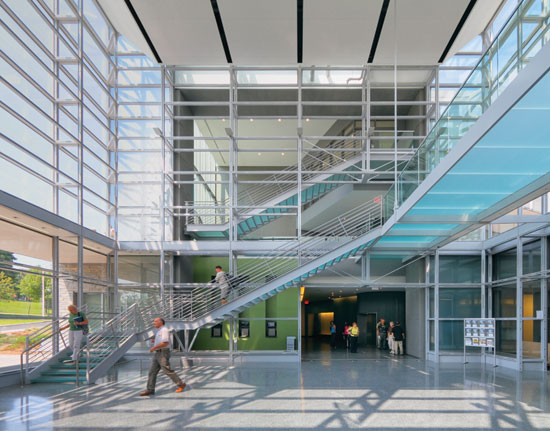
Photo © Jeff Goldberg/Esto
The Gateway Center pavilion’s stair and bridge enhance circulation between the center’s two academic wings.
As primarily a commuter school, Westchester Community College long lacked a centralized hub on campus, a place both to welcome students and offer them a comfortable space in which to congregate. The school also needed to expand its overburdened facilities, particularly for its English as a second language and business departments. With an eye toward fixing this state of affairs, the institution hired Ennead Architects to design a new building that would include classrooms, offices, language and computer labs, an auditorium, and, most importantly, an architecturally inspiring public space. Working in close collaboration with structural engineers LERA, Ennead developed the idea of creating an entryway for the campus. In architectural terms, the concept addressed the theme of a threshold that would rest with a weightless quality atop the college's carefully landscaped grounds. In material terms, this led the team to one solution: architecturally exposed structural steel (AESS).
As part of the overall design, an AESS stair and bridge connect lobby and upper level corridors that are open to each other. Ample space above and below allow for people to stop and meet. Both stairs and bridge are fabricated out of PL 1-3/4-inch by 12-inch structural steel stringer plates and channels. The treads of the stair and floor of the bridge are made from laminated glass panels that keep daylight moving freely through the space. At midspan, two steel hangar rods connect the bridge to the pavilion's main stringers via custom pin and jaw fittings designed by LERA.
One of the factors that played into the choice of structural material was cost. “This was a Wicks Law job where anybody could bid” explains Ennead design partner Susan Rodriguez. “To ensure that we would get good results no matter who won the contract we worked with LERA and created a modular system.” The prefabrication possibilities of structural steel, as well as its relatively fast erection process, allowed the team to realize the project's design intent without greatly increasing its budget.
“On a conceptual level we wanted to build a bridge between a manufacturing process and a custom fabrication process,” adds Dan Sesil of LERA. “Most of our buildings involve unique structural conditions that add time and money to a project. There's some of that here, but by creating a building block that leant itself more to manufacturing we were able to deliver a custom appearance without the fussy fabrication process. Steel was the natural choice for that.”
At a total cost of $33 million, the Gateway Center is a 70,000-square-foot, three-story building with two academic wings that embrace a landscaped courtyard. At the convergence of the two wings is a 48-foot-tall glass pavilion that serves as the lobby and welcome center. It was here that the designers put into play their modular system: 233 AESS boxes stacked one atop the other and forming a slim profile grid structure that supports the glass volume.
Focal Points—Stairs as a Feature
All of the example buildings we have discussed so far have used interconnecting stairs as a feature element of the total design to some extent. Taking that thought one step further, let's look at three others that use ornamental as a stand-alone design element.
Alice Tully Hall at Lincoln Center
Location: 1941 Broadway, New York, NY
Architects: Diller Scofidio + Renfro, New York, NY,
in collaboration with FXFOWLE Architects, New York, NY
Structural Engineer: Arup, New York, NY
Miscellaneous Metals Engineer: Anastos Engineering Associates, New York, NY
General Contractor: Turner Construction Company, New York, NY
Miscellaneous Iron and Ornamental Metal Fabricator and Erector:
Post Road Iron Works, Inc., Greenwich, CT
Although it is one of the most often used venues in Lincoln Center, Alice Tully Hall hadn't had a renovation since its opening night in 1969. And though The Juilliard School surrounding it had never faltered in its ability to develop world-famous performing artists, it was in much need of a makeover that would add practice rooms, classrooms, and office spaces. The long-overdue redesign, undertaken by Diller Scofidio + Renfro in collaboration with FXFOWLE Architects, strips away the opaque façade at the base of Pietro Belluschi's original scheme, revealing the entrance lobby and Juilliard's inner workings to the street. The dramatic physical, and symbolic, gesture was made possible by Arup's structural engineers, who developed a 50-foot steel truss cantilever that serves the dual purpose of creating a soaring entrance to Alice Tully Hall while expanding the school's practice space overhead.
Like the pieces performed there, the project was complex and multilayered. Despite this, the new space is marked by a transparent, column-free lobby created by a unique geometry of intersecting tilted planes. It also includes visible, interconnecting stairs that readily show the means to ascend from the lobby to several upper floors that are visible through the transparent curtain wall façade. The guardrails on the upper levels are opaque but brightly painted on the inside providing a strong design statement. “We talked about doing a big gesture, in the spirit of the big volumes of the building,” says Sylvia Smith, senior partner in charge of the project for FXFOWLE, of the team's initial design meetings. The resulting shape reaches toward Broadway, creating a welcoming space that beckons visitors inside.
Numerous steel and slab elevation changes and ramps allow larger spaces in the building to mesh with the existing building's floor-to-floor elevations, as well as to accommodate various acoustic and performance floor build-ups throughout the expansion. According to Smith, it is the building's unique steel “warp and weft” that enabled the architects to weave so many varied spaces into the 100,000-square-foot structure, replacing the somewhat detached Belluschi design with a brightly lit tableau. Seen at night, the transparent building almost resembles a page of sheet music come alive as teachers and students, performers and audience members, rise and descend on the stairs through its levels, honoring Lincoln Center's history while creating a new image of its future.
Rockefeller University Collaborative Research Center
Location: 504 East 63rd Street, New York, NY
Owner: The Rockefeller University, New York, NY
Architect: Mitchell/Giurgola Architects, LLP, New York, NY
Structural Engineer: Severud Associates, New York, NY
Construction Manager: Turner Construction Company, New York, NY
Miscellaneous Iron Erector: Post Road Iron Works, Greenwich, CT
Ornamental Metal Fabricator and Erector: Champion Metal and Glass, Deer Park, NY
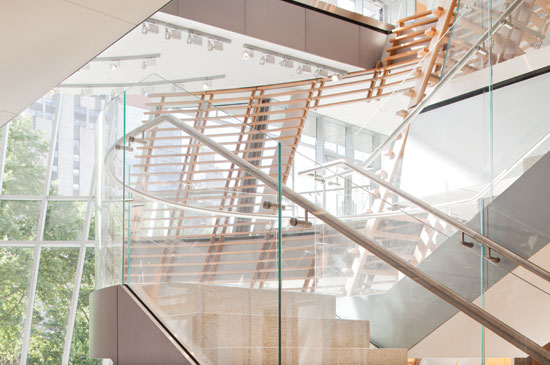
Photo © Adam Friedberg
Recessed glass handrail shoes hidden by painted aluminum fascias and custom stainless steel railings and stand-offs maintain the stair’s weightless appearance in the atrium at the Rockefeller University Building.
When the Rockefeller University began thinking about its future in the next millennium, it turned to two buildings that had helped foster more than 20 Nobel Prize-winning scientists during the past century. The buildings, Theobald Smith Hall, built in 1930, and Flexner Hall, built in 1917, form the historic northeast corner of the 14-acre Manhattan campus. To continue the university's outstanding legacy of achievement, both buildings needed updating of their facilities, as well as of their institutional model.
The university hired New York based Mitchell/Giurgola Architects to undertake a gut renovation of these two obsolete research buildings. Bridging the open space between the two buildings—literally and figuratively—they added a seven-story atrium designed to facilitate interaction between Rockefeller's scientists. As a symbol of the collaboration that will take place there, this dramatic elliptical atrium, enclosed by a metal and glass curtain wall and, on the interior, by a wooden lattice structure, offers a glimpse of the university's forward-thinking vision while respecting its past accomplishments. The architects' goal of creating a light-filled space in which scientists can meet and share ideas involved several key design considerations, both practical and creative. Maintaining a line of sight through the bridge building was important yet complicated because the buildings' longitudinal axes are at right angles to one another. The designers decided the new curtain wall would serve their needs best and provide a linkage between the interior stair area and the outdoors. “We are very happy with the transparency of the curtain wall,” says Jillian Sheedy, senior associate at Mitchell/Giurgola.
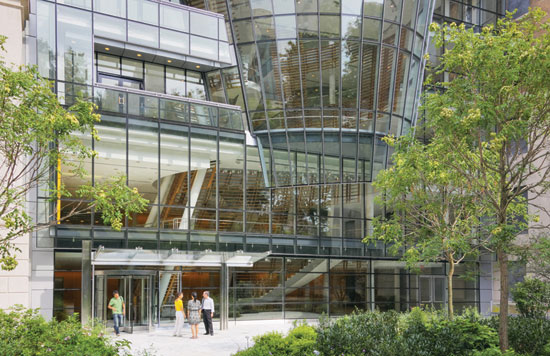
Photo © Adam Friedberg
A stair designed to foster interdisciplinary collaboration is located within a central atrium of the Rockefeller University Building.
Inside the atrium, scientists have a number of open lounge and meeting spaces and glass-enclosed conference rooms, five of which are all-glass circular enclosures equipped with audio-visual technology. The atrium has an enhanced smoke control system that exceeds the requirements of the NYC Building Code. In the event of a fire, motorized windows open, allowing rooftop fans to exhaust smoke while drawing fresh air into the building. Connecting the atrium and the bridge floor levels is a monumental stair, which appears weightless by the incorporation of all-glass guardrails set in metal shoes. Ornamental metal fabricators had to set each shoe precisely at a 90-degree angle to the stair, ensuring that glass panels lined up perfectly. Recessing the rigid shoes behind the painted aluminum fascias contributed to the stair's weightless appearance. Stainless steel handrails are attached to the ½-inch-thick glass with custom stainless steel stand-offs that not only highlight the staircase's form, but also ensure its safety.
26 Broadway Educational Campus
Location: 26 Broadway, New York, NY
Owner: NYC School Construction Authority, New York, NY
Architect: John Ciardullo Associates P.C., New York, NY
Structural Engineer: John J. Ciardullo, R.A., New York, NY
Construction Manager: Pavarini McGovern, New York, NY
Structural Steel Erector: Midtown Heights, Inc., Secaucus, NJ
Miscellaneous Iron, Architectural and Ornamental Metal Erector: Transcontinental Contracting, Newark, NJ
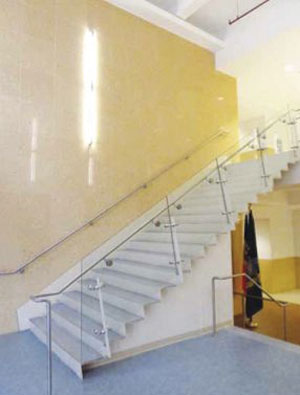
Photo © Anna-Marie Kellen
At 26 Broadway, many convenience stairs cut down on the students’ use of elevators in the multiuse building. In the one pictured, the stair’s top riser and tread are welded to a lateral beam with its flange removed thus allowing the stair to function as the beam top chord, creating a less bulky design.
The landmarked Standard Oil Building at 26 Broadway in New York City has been recently transformed from the oil giant's Carrère and Hastings- designed headquarters into a lively academic complex for secondary students in Lower Manhattan. The third academic institution to be located in the building, it occupies 104,000 square feet of space on the first, mezzanine, and second levels and adds nearly 700 high school seats to what the New York City School Construction Authority (SCA) calls its Broadway Educational Campus. The entire complex, which also includes the Urban Assembly School of Business for Young Women (on the 4th and 5th floors) and the Lower Manhattan Community Middle School (on the 6th and 7th floors), was designed by New York-based architecture firm John Ciardullo Associates, who has worked extensively on projects with SCA for several decades.
The SCA has long recognized the benefit of turning existing steel-framed structures into schools. As the city's need for classroom seats grows, existing buildings like this one offer the flexibility to create new openings between floors—a crucial aspect of any vertical urban campus. At 26 Broadway, use of the elevators was restricted by a business agreement between the owner and SCA, so the architects designed a convenience stair connecting the school's four floor levels to limit elevator use. But creating the staircase required removal of a structural steel column to make room for the opening. The remaining column adjacent to the stair opening was supported laterally by steel beams at each level, so Ciardullo, also the project's structural engineer, had to calculate how many beams could be removed to create the opening. “I knew the size of the steel column and I had the weight of the steel structure, so we did an analysis to determine the acceptable unsupported height of the column,” says Ciardullo. “Since I had the size of the columns to calculate the buckling effect and column width by taking out the lateral support at one floor, we were able to then determine that the existing column could take the elimination of the lateral support beam and handle the buckling effect, the non-lateral support, at each floor.”
Ciardullo also designed a solution to eliminate some bulk from the area where the top of the stair attached to a lateral steel beam. Normally, plates would be fastened to the top of a wide-flange beam to support the stair risers and treads. “It would create a very bulky structure,” said Ciardullo. Instead, the team cut away the top flange of the lateral beam welding the topmost stair riser and tread to the beam and thus allowing it to function as the beam's top chord. The stairs were fabricated in flights from Grade A36 plate and hoisted into the building through a window.
Design Elements—Stairs as Art
Having acknowledged the ability of interior stairs to be a specific design feature, the advancement of that thought is to turn them into a work of art in their own right. Here are two examples of buildings where that was exactly the goal of the architects involved.
Museum of Art and Design
Location: 2 Columbus Circle, New York, NY
Owner: Museum of Arts and Design
Architect: Allied Works Architecture, New York, NY
Structural Engineer: Robert Silman Associates, New York, NY
Construction Manager: F.J. Sciame Construction Co., Inc., New York, NY
Structural Steel Fabricator and Erector:
Cross County Contracting, Inc., Pine Bush, NY
Miscellaneous Iron and Architectural Metal Fabricator and Erector: United Iron, Inc., Mt. Vernon, NY
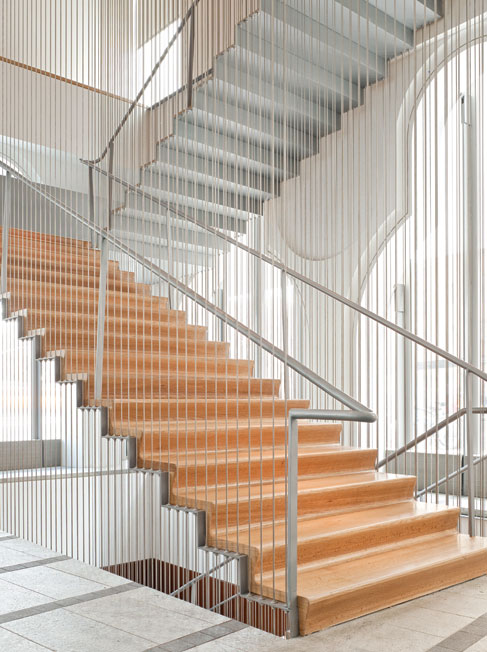
Photo © Adam Friedberg
The stair at the Museum of Arts and Design fulfills the architect’s vision of a transparent, floating structure that allows visitors to move between floors with ease.
The new Museum of Arts & Design (MAD) is a reinvention of Edward Durrell Stone's modernist palazzo at 2 Columbus Circle in New York City. The new design by Brad Cloepfil of Allied Works Architecture (AWA) touched off an impassioned preservationist debate by radically altering the original facade. But even those squeamish about the new light-admitting exterior agree that changes to the interior—notably the museum lobby's new ornamental entrance stair—were sorely needed to correct functional shortcomings that long plagued the original design.
Isolated on a miniscule island of prime Manhattan real estate, MAD contains a mere 4,500 square feet at street level—not much for a museum lobby intended to host 500,000 visitors annually. Nonetheless, both the client and architect determined that an elegant stair, while space taking, was vital to the project. “There was a desire to allow people to move up from the lobby quickly,” says AWA partner Kyle Lommen, referring to the stair as a device for preventing newcomers from falling victim to elevator gridlock. “There is also a ceremonial quality in moving between a gallery and the lobby by another means than the elevator.”
For AWA founder Cloepfil, the aesthetic goal was “to have the stair be as transparent as possible and to float in space. We wanted the ceremony but we didn't want it to become a major spatial plug. The quality of the structure, the floating metal plate, is just structural transparency.” Realizing this vision of something so sheer that it didn't visually intrude in the small lobby required some literal heavy lifting.
The stair, which extends from the cellar floor to the second-floor gallery ceiling, is suspended on 300 6mm 1x19 stranded wire cables tensioned to approximately 900 pounds. Each of the woven stainless-steel stringers, which list a minimum breaking strength of 22.0 kN, measures ¼ inch in diameter. Spacing is 2½ inches on center to also function as a balustrade. No such installation had been attempted before by anyone who worked on the project. In that vein, Lommen says choosing a subcontractor “came down to who really wanted to take it on.” The successful bidder was United Iron, Inc. (UI), and President Randy Rifelli concurs with a laugh, “It was beyond a challenge! It was one of the most difficult jobs we've ever done. And it was unknown, this concept of hanging stairs on cables without supports.” UI's first step was to fabricate the 3/8-inch-thick A36-grade steel plate that appears to run among the three floors without a seam. Steel plates were welded together to form the stair's risers and treads. Then each fully welded plate combination was welded to the next riser-tread module. The stair assembled into four main sections with two separate landing sections. Rifelli says his team used partial-penetration welds at each plate connection throughout the stair. Because four cables penetrated each tread, and each cable is single-span, “the cable ran through four points of the stair and it was critical that they line up perfectly. The visual vertical alignment is what provides the architectural splendor. To weld each plate to each other and to accurately drill the multitude of holes for the cable spacing was the tough part. To our surprise the lineup of the holes was better than expected.”
With assembly completed, the stair sections were delivered to the project site on dollies, then hoisted into place via electric chain fall. Because the finish cables of the stair were only 3 inches from the walls, the cables could not be installed until the walls were finished. “The stair stayed on designed temporary channel supports for months while the walls were finished by other trades,” Rifelli says. Indeed, the tight installation required careful project choreography. The plan was to have a maximum amount of finish work completed, with just minimal building structure exposed, when the stair was initially put in place. To finish the stair, the crew welded the sections together—performing on-site bead blasting at the welded location to complete the finish—and then installed and tensioned the cables for the stair. Just as they tensioned the cables by hand at the structural supports, United Iron's crew also performed the meticulous work of manually threading the 300 cables through their corresponding holes, and then of clamping and pinning them to the treads. White oak tops the riser treads, appearing to cascade down the angular bent steel.
Although one of the building's most expressive, and controversial, features is its new skin, it is the lobby stair's seemingly unprecedented construction that represents the best of Cloepfil's design—the derring-do of the structure and its commitment to skilled execution.
The Queens Museum
Location: New York City Building, Queens, NY
Owners: Queens Museum, Queens, NY; New York City Department of Design & Construction, New York, NY
Architect: Grimshaw Architects, New York, NY
Executive Architect: Ammann & Whitney, New York, NY
Lead Structural Engineer: Ammann & Whitney, New York, NY
General Contractor: Volmar Construction Inc., Brooklyn, NY
Construction Manager: URS Corporation, New York, NY
Architectural Metal Fabricator and Erector: CAPCO Steel, Providence, RI
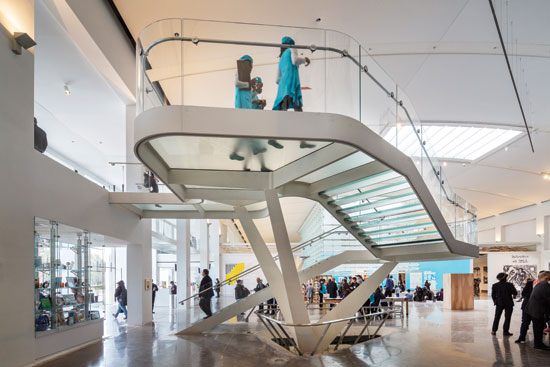
Photo © David Sundberg/Esto
The Queens Museum uses an innovative stair and circulation system to update an older building with a lot of history.
The Queens Museum in Flushing, New York, has undergone more renovations than most buildings and certainly more than any structure intended for show at most World's Fairs. Originally designed by Aymar Embury III to house the New York Pavilion in the 1939 World's fair, it has subsequently functioned, among other things, as the initial home of the fledgling United Nations General Assembly, and as exhibition space for the 9,335-square-foot architectural model depicting Robert Moses's Panorama of the City of New York featured at the 1964 World's Fair. Despite this storied past, few knew of its existence. The building's blank, unarticulated facade—which countless commuters pass each day—was an opportunity to alert vehicular passersby of the museum's presence.
Since the building was established as a museum post–World's Fair in 1974, Grimshaw Architect's renovation has nearly doubled the institution's square footage to 105,000 square feet. Newly defined entrance points that now direct visitors through the large central gallery to various specialty and temporary exhibitions are equipped to meet the Museum's charge: To attract approximately 200,000 members of the Queens borough community through engaging art, history, and educational programming.
Effectively dealing with this increase of use meant adding a new circulation and stairway system that could be treated as an artistic and functional element. One of the unique features designed by the architects is a triple-tiered glass and metal staircase that carries visitors to what is arguably the museum's best known exhibition; the Panorama of New York. The free-form shape was modeled extensively using two different computer software programs, says Joel Stahmer, vice president at Ammann & Whitney, whose firm served as engineer of record. “What's unique about the staircase is that it uses no off-the-shelf, rolled shapes; every section is custom built.”
The base of the stairs sports a configuration to echo the shape of the Unisphere in the distance, set within a new pile foundation that supports the stairs. Three, three-sided masts fan upward to support three landings at shorter intervals that are more like a terraced descent than an abrupt experience. The first landing is approximately 8 1/2 feet above the ground floor, the second landing is at approximately 12 1/2 feet, and the top landing reaches a height of 14 1/2 feet. The delicate apex at the base also keeps the ground level uncluttered, accounting for three existing columns that support the Panorama.
Conclusion
Ornamental stairs can be a vibrant, appealing, and even critical programming element in many different types of buildings. By connecting related areas, people also connect easily and improve the way they communicate—and collaborate—with others in the building. By designing in other, related spaces adjacent to or as part of the stairway, people will linger and network in this space. From a visual standpoint, the stair itself can be viewed as a design element that is part of a circulation or gathering space. Taken to the highest level, it can serve as an artistic contribution in its own right. In all cases, allowing occupants an attractive and readily accessed option to using an elevator in multi-story structures creates building environments that are truly enhanced and appreciated by the people in them.
 |
The Ornamental Metal Institute of New York is a not-for-profit association created to advance the interests of the architectural, ornamental, and miscellaneous metal industries by helping architects, engineers, developers, and construction managers transform designs into reality. www.ominy.org |
